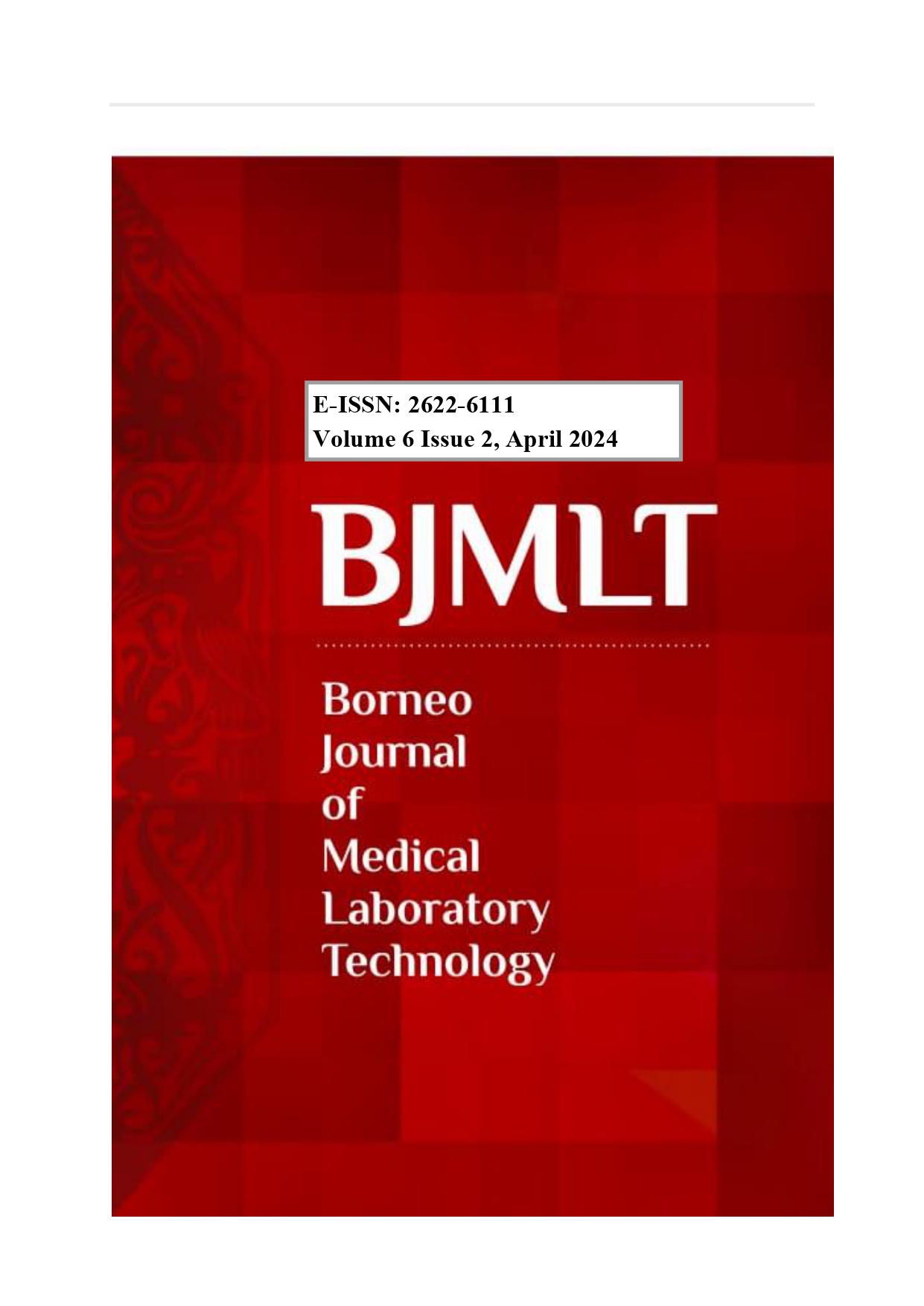Potensi Dan Uji Stabilitas Ekstrak Lawsonia Inermis Sebagai Cat Penutup Pada Gram Staining Dengan Variasi Suhu
Potency and Stability Test of Lawsonia inermis Extract as Counterstain on Gram Staining with Temperature Variation
DOI:
https://doi.org/10.33084/bjmlt.v6i2.6736Keywords:
Lawsonia inermis, Stability Test,, Gram Staining, SafraninAbstract
Gram staining is one of the methods used for bacterial identification. Safranin is one of the dye substances employed in Gram staining. The toxicity and health hazards associated with the use of safranin have been extensively reported, especially the risk of contamination from synthetic dye waste. The use of synthetic dyes is highly hazardous as it can lead to cancer, kidney, and liver damage. A potential alternative for Gram staining is the use of henna leaves (Lawsonia inermis), which contain the dye substance lawsone. However, natural dyes are susceptible to temperature changes.This research aims to determine the ability of henna leaves to stain bacteria as a counterstain in Gram staining and to assess the temperature stability of the henna leaf extract under various temperature variations. This study is a qualitative descriptive research with an experimental design conducted in the Microbiology Laboratory of the Faculty of Health Sciences at 'Aisyiyah University Yogyakarta. The results of Gram staining for Gram-negative bacteria (Escherichia coli) at temperatures of 40°C and 80°C show no contrast with the background, while Gram-positive staining for Staphylococcus aureus appears contrasting against the background. It can be concluded that the Gram staining of Escherichia coli bacteria with Lawsonia inermis extract at temperatures of 40°C and 80°C yields staining results that lack contrast between bacterial cells and the background. In contrast, Staphylococcus aureus bacteria exhibit contrasting staining results between bacterial cells and the background. The stability test of Lawsonia inermis extract indicates greater stability at 40°C compared to 80°C
Downloads
References
Edyani, J. S., Widyantara, A. B., & Novalina, D. 2020. Systematic Review: Pemanfaatan Bahan Alami Sebagai Pewarna Alternatif Pengganti Safranin pada Pewarnaan Gram. Disertasi. Universitas ‘Aisyiyah Yogyakarta, Yogayakarta.
Miftahul, K. 2021. Identifikasi Ekstrak Ubi Jalar (Ipomea Batatas Poiret) sebagai Zat Pewarna Alternatif pada Pewarnaan Gram. Skripsi. Universitas Perintis Indonesia, Padang.
Niken, N., & Yulia, I. 2023. Innovation of extract (Lawsonia inermis L) as alternative dye for Escherichia Coli bacterial staining. International Journal of Multidisciplinary Approach Research and Science, 1(03):512-517.
Nasrullah, N., Husain, H., & Syahrir, M. 2020. Pengaruh suhu dan waktu pemanasan terhadap stabilitas pigmen antosianin ekstrak asam sitrat kulit buah naga merah (Hylocereus polyrizus) dan aplikasi pada bahan pangan. Chemica, 21(2):150-162 .
Nurmasari, R., Umaningrum, D., & Yuliyanti, E. 2018. Kajian Sorpsi Zat Warna Safranin O Pada Sorben Beads Kitosan-Tripolifosfat. Sains dan Terapan Kimia, 12(1):34 – 40.
Oktaviani, I. M. 2016. Pengaruh Rebusan Daun Pacar Kuku (Lawsonia inrmis Linn.) terhadap Penurunan Kadar Asam Urat Mencit Jantan (Mus muculus L.). Skripsi. Univeritas Jember, Jember.
Pujilestari, T. 2015. Sumber dan pemanfaatan zat warna alam untuk keperluan industry. Dinamika Kerajinan dan Batik, 32(2):93-106.
Rini, C. S., & Rohmah, J. 2020. Buku Ajar Mata Kuliah Bakteriologi Dasar. Umsida Press, 1-108.
Setiana, Shella. 2015. Pengaruh Konsentrasi Mordan Kapur Dengan Zat Warna Daun Pacar Kuku (Lawsonia inermis) Kering Terhadap Pewarnaan Kain Knit Cotton Dengan Teknik Tie Dye. Jurnal S1 Tata Busana, 4(3):38-43.
Susanto, H. 2016. Pemeriksaan Protozoa, Helminthes. Depok, PPPPTK Bisnis dan Pariwisata.
Yusuf, T. M., Nurjanah, A., & Wapa, A. 2023. Karakteristik Uji Stabilitas Pigmen dan Antioksida Hasil Ekstraksi Pewarna Alami dari Kulit Buah Naga Merah. SOKO GURU: Jurnal Ilmu Pendidikan, 3(1):163-176.
Downloads
Published
How to Cite
Issue
Section
License
Copyright (c) 2024 Nida Azki Asfiya, Dhiah Novalina, Tri Dyah Astuti

This work is licensed under a Creative Commons Attribution-ShareAlike 4.0 International License.
All rights reserved. This publication may be reproduced, stored in a retrieval system, or transmitted in any form or by any means, electronic, mechanical, photocopying, recording.
